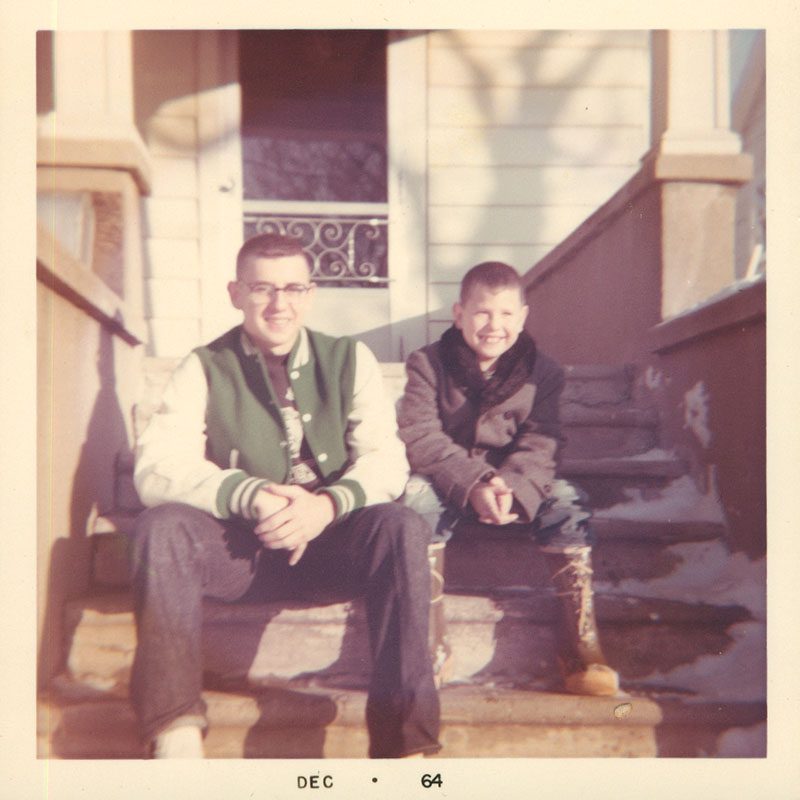My formative years, from grade school through twelfth grade, were spent in a house my grandfather built on Miner St. I can’t imagine a better place to get started in life.
Let me take you back to 1957 in the neighborhood now known as Water Hill. We called it the West Side, not to be confused with the Old West Side Historic District south of Huron—that didn’t exist yet. Our neighborhood was a few blocks north, and newer, with many homes built in the 1940s and 1950s.
My dad worked for Michigan Bell and my mom had her hands full organizing the household for two grown-ups and four kids. My two older sisters plowed the way, leading mom and dad through the initial perils of parenting. Because I was five years younger I mostly cruised under child-rearing radar. My parents thought, “Mikey is a breeze compared to Jo and Barb.”
How could two sweet young ladies be a parenting challenge? When I was seven years old they warned me not to disturb their paper dolls: “You will regret it!” Naturally, I ran amok with all of the dolls and associated paper clothing options.
My grandfather was big on laundry chutes: ours was three feet square and dropped three stories, straight into the basement. Lucretia and Mad Madam Mim tossed me, kicking and screaming, into the chute from the second floor.
It was a quick trip to the basement. Fortunately, the incident occurred just before laundry day and I landed pretty softly. My mother plucked me out of the bin and the siblings were grounded for a month.

Mike and Ed in 1964. | Courtesy of Mike Sinelli
On a summer day I would pop out of bed and make my own breakfast: a bowl of cereal or cocoa and toast. I was now free to pursue all of the entertainment opportunities the West Side offered.
This morning it would be baseball. Every morning, a group of kids would meet up at Hunt Park and organize a marathon baseball game. I put on my Tigers cap, stuffed a baseball in my pocket, and retrieved the Al Kaline signature Louisville Slugger from the corner of my bedroom.
It was amazing that Al and I had the same taste in bats: We liked a thin handle for a better wrist snap and large barrel that was a little more forgiving when you made contact with the ball. Al’s bat was thirty-four inches long. Mine was twenty-nine. As far as I was concerned, that was the only difference.
I dragged my bike off the front porch, threaded my glove on the handlebars, and straddled the bat across the handlebar between the grips. Off to Hunt Park.
Hunt Park offered two backstops facing each other from opposite corners of the park and a pitcher’s mound for each diamond. There was no precut infield, but the base paths were heavily grooved by hours of play from the sandlot teams. Anyone was welcome to play. Girls, boys, anyone between seven and eleven years old. We named two captains and went through a ritual with a bat, slightly more complex than the theory of relativity, to determine who would get the first pick from the dozen players. Sides chosen, we played ball.
The games lasted for hours. Twenty or thirty innings. All of us developed and honed our baseball skills much more on the sandlot than we did in official Little League play.
We had formal rules and informal rules.
Formal rules were: “Pitcher’s box is out. No walking. No catcher [we did not have the requisite equipment]. If the teams have fewer than five players a side, right field is closed—anything hit to right is an automatic strike.”
Informal rules were you did not take advantage of the weaker players. When a seven-year-old came to bat you pitched the ball softly and underhanded. You might throw a cross-body block on an eleven-year-old when you were trying to score but no one ran over a seven-year-old. Nothing I ever did later in life emphasized a sense of fair play more than sandlot baseball at Hunt Park.
After baseball we had lunch. Standard fare was PB&Js or bologna sandwiches prepared for the horde by one of the moms.
Following lunch we might decide to race our dirt bag soap box derby cars down Daniel St. Five or six of us made race cars out of spare wagon parts, with two-by-four axles, and two-by-six chassis. We steered with ropes tied to the front axles. No brakes.
Daniel St. was perfect: There was a very steep hill starting at Sunset Rd. but toward the end of Hunt Park there was an upslope, so we all coasted to a stop. Clear vision, no side streets, little traffic. Spring St. on the other hand was totally downhill, three stop streets, heavy traffic, lots of trees. Our test run down Spring resulted in one broken arm and lots of scrapes and bruises. After five or six runs on the Daniel Track, someone was awarded the Barney Oldfield trophy and we moved on.
The West Side was a working-class neighborhood and dinnertime was pretty standard: I had to be home at five and cleaned up for dinner forty-five minutes later. Dinner was served to the whole family at 6 p.m. every weekday.
We took turns at the dishes and then we went out to play with kids on the block. Could be anything: touch football in the street, Frisbee tag, hide-and-seek, Wiffle ball, maybe a low-profile card game on the front porch. The old adage that we had to be home when the streetlights came on is a little misdirected. The real rule was “We don’t want you home until the streetlights come on.”
The West Side is rife with parks. Hunt Park offered excellent sandlot, football, and basketball facilities. In the winter, there was a great open hill that was ideal for sledding. West Park was only three blocks from my house and it provided even greater recreational opportunities: a fully maintained Little League baseball field and a spectacular full-size baseball diamond complete with dugouts. A semi-pro baseball team, the Ann Arbor Travelers, played every weekend during the summer. All the home games were at West Park. For four years, I was their batboy.
West Park also offered a wading pool to cool off on 90-degree days. The band shell hosted community music performances of all types. In the winter, the baseball diamond was flooded and served as a public ice skating rink. My sister Barb had visions of becoming the next Sonja Henie, so she spent many days and nights perfecting her figure eights there. The rink was lighted and there was a heated portable shed to warm you up on cold windy days. We played “crack the whip.” The person at the end of the whip achieved speeds near the sound barrier. He or she was usually launched completely off the rink and over the surrounding snowbank.
Related: Coming of Age at State and Packard
712 N. Main St.
A Crop of Mailboxes
Another great feature of the West Side was the proliferation of mom-and-pop stores. There were three within three blocks of our house and four more within six blocks. They were a necessity for mid-1950s lifestyles, because most families only had one automobile. That vehicle went to work with the working parent. So whenever Mom needed sugar, noodles, a can of soup, or even a pack of Camels, she sent me a block and half south to Tom’s Miner Street Grocery.
This was always a great opportunity for me. There was a two-cent deposit on longneck bottles in Michigan. Doesn’t sound like much. But in 1957 a full-size Snickers candy bar was a nickel. A Faygo Creme Soda was a dime. So for three pop bottles, I could get a Snickers and a piece of Dubble Bubble chewing gum.
Out of necessity, we all became capitalists. The family budgets were tight. Very rarely did discretionary income trickle down to the kids. No problem. We all had our eyes open for longneck beer and pop bottles and I had a few lawn mowing and snow shoveling customers.
Two of my more creative enterprises were in the recycling industry and the wholesale bait and tackle business. Every month or so, I would drag the wagon out of the basement and tour the neighborhood asking for old newspapers and magazines. Most of our neighbors saved these. In fact they saved almost everything. These people had survived the Depression and you never knew when you might need to wrap fish or line the bottom of the birdcage. When the piles got really big, they were happy to have me carry off the excess.
I would take the papers home and bale them up with twine. When I had stowed enough to fill the trunk and back seat of our ’55 Mercury, my dad and I would load up the car and drive them to Lansky’s junkyard on Main St. Lansky paid me bulk pound prices for the paper. I raked in three or four dollars a carload. I bought my first Argus camera with money from my “paper route.”
My friend Jimmy’s father was an avid fisherman. He determined that the perfect bait for big bluegills was wild black crickets. He offered the exorbitant sum of a penny per cricket for as many as we could deliver. During the day the crickets would hide under boards and rocks in the fields around the West Side. These guys were actually pretty fast, and when you flipped the boards they started to move. So Jimmy and I would take turns being the board-flipper and the cricket-catcher. More than once we flipped a board and were about to pounce when we found the den was occupied by a large spider, a snake, or field mice. Occupational hazards. Jimmy and I always split the proceeds and netted at least a dollar a month during the summer.
We never worried about having the opportunity to make enough money. That perspective stayed with me my entire life, and I learned it at age nine on Miner St.
I was very fortunate to grow up on the West Side of Ann Arbor. We had a lot of fun. My parents instilled solid values in their four children. The need for equal opportunity and fair competition. The benefits of self-reliance and acquiring skills that were needed in the community. These values were reinforced by our peers on the West Side.
I remember these lessons as I pass through life. Most importantly, I never touch anyone’s paper dolls.

